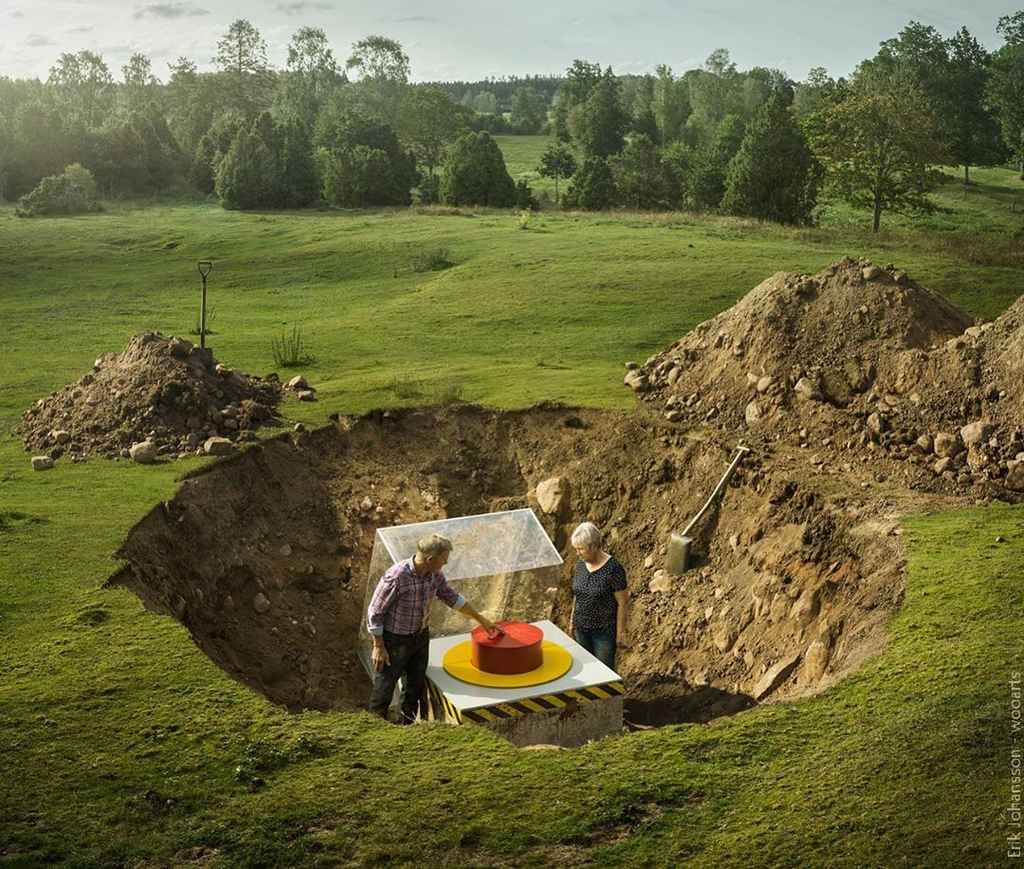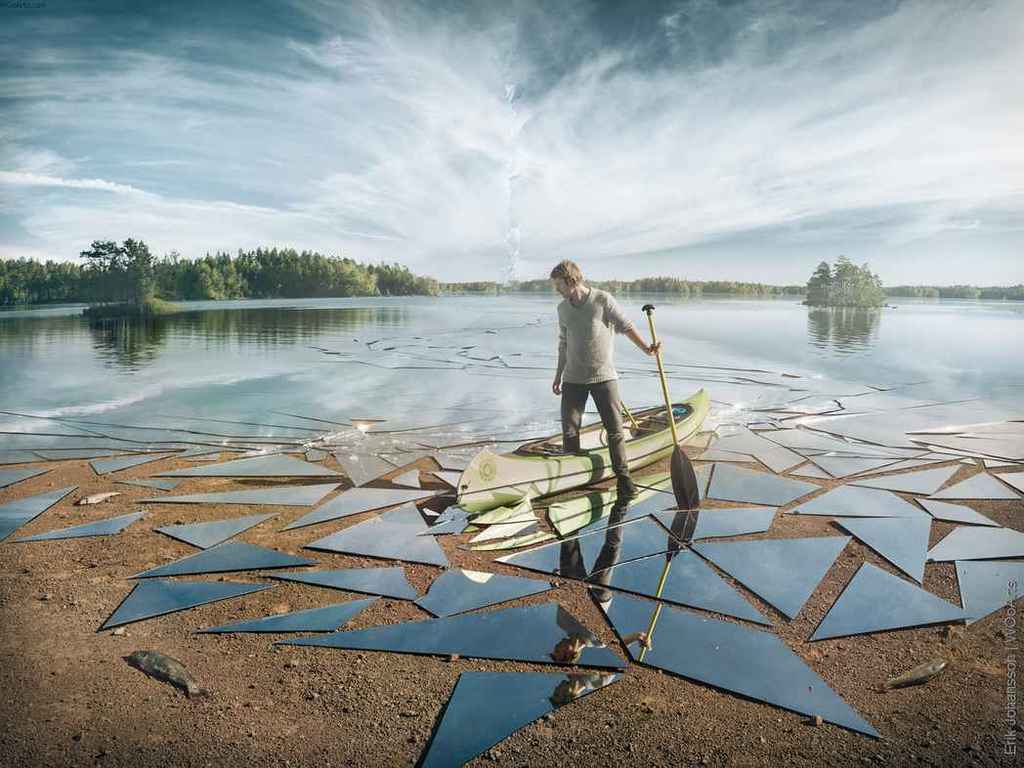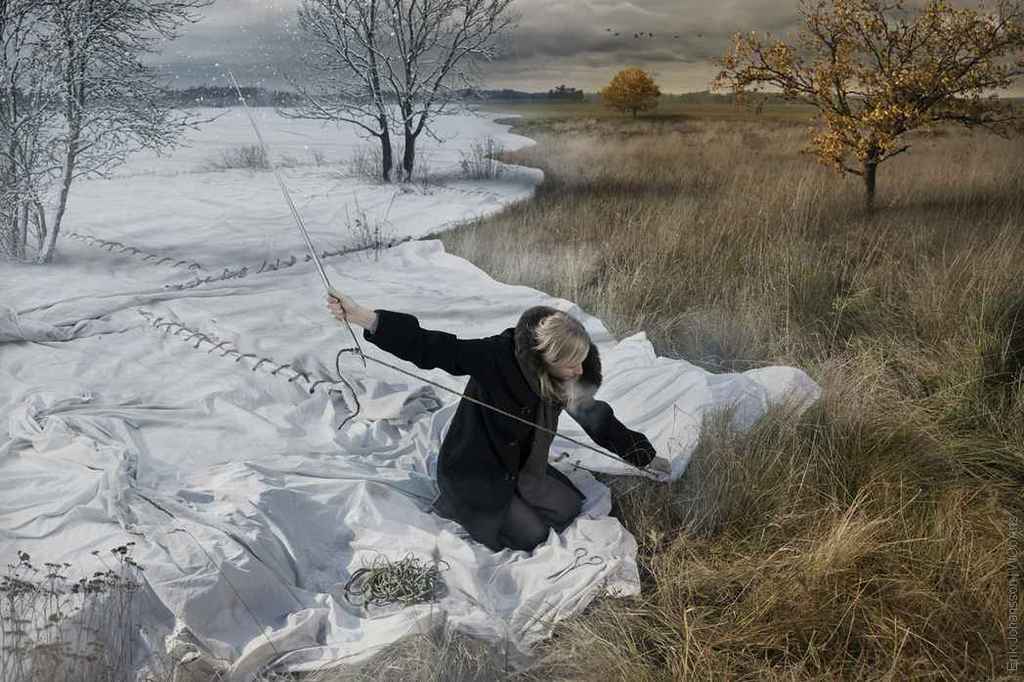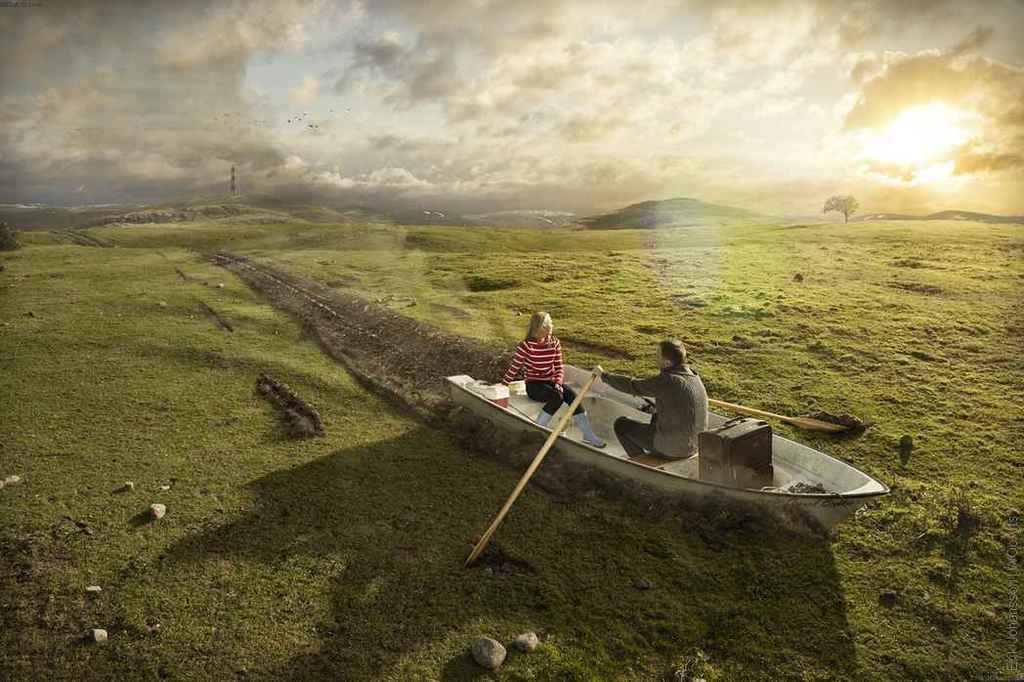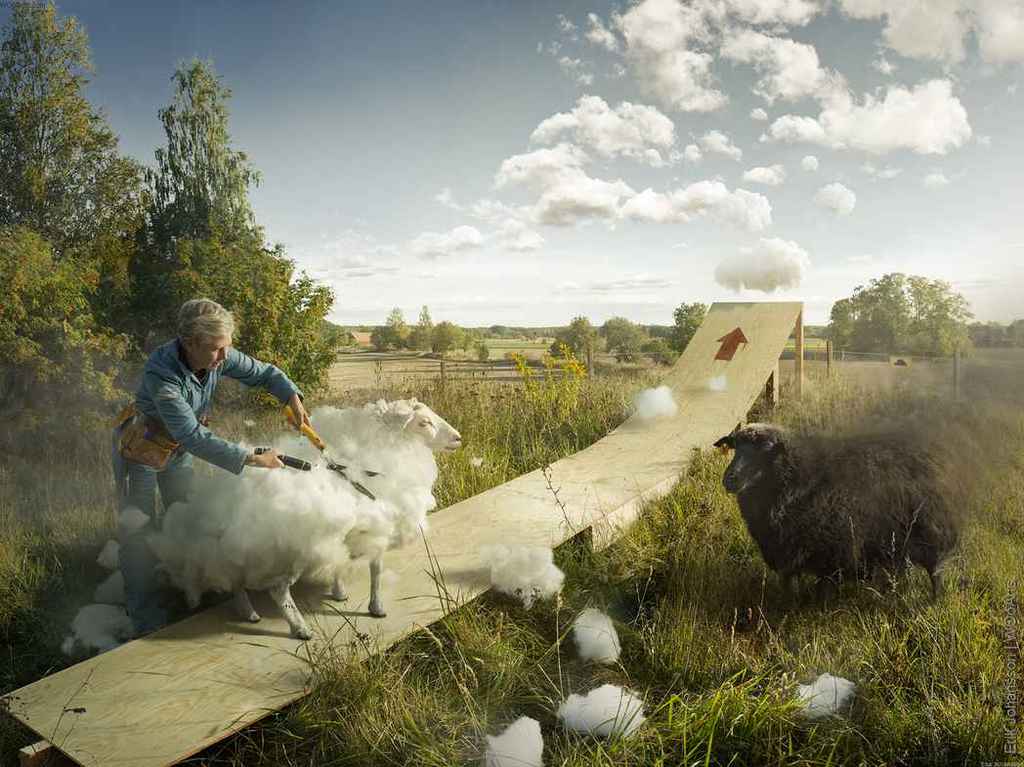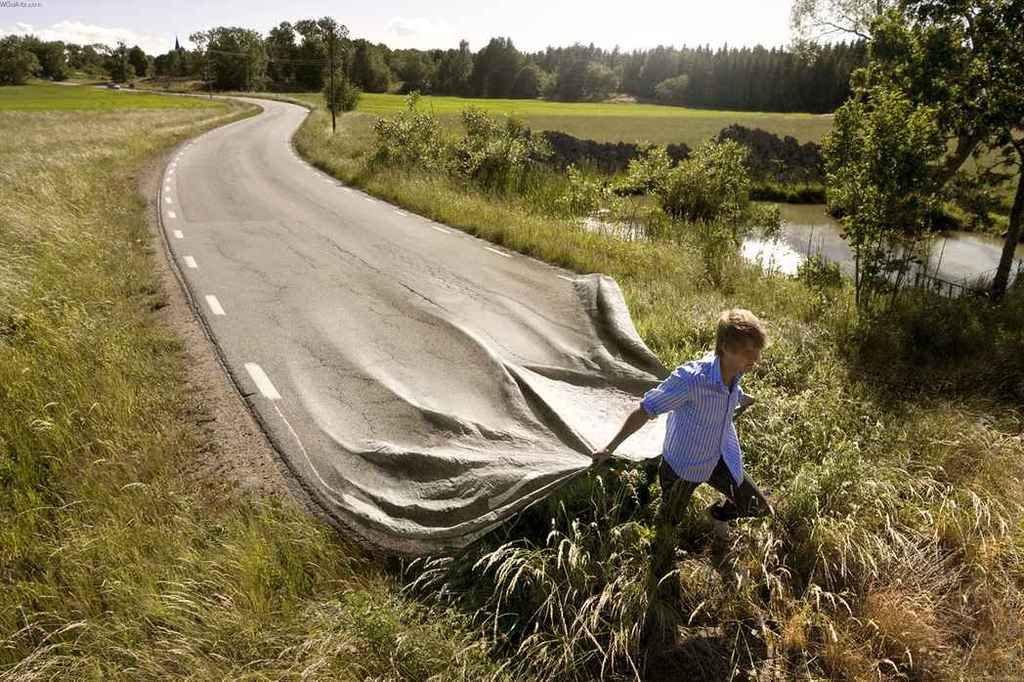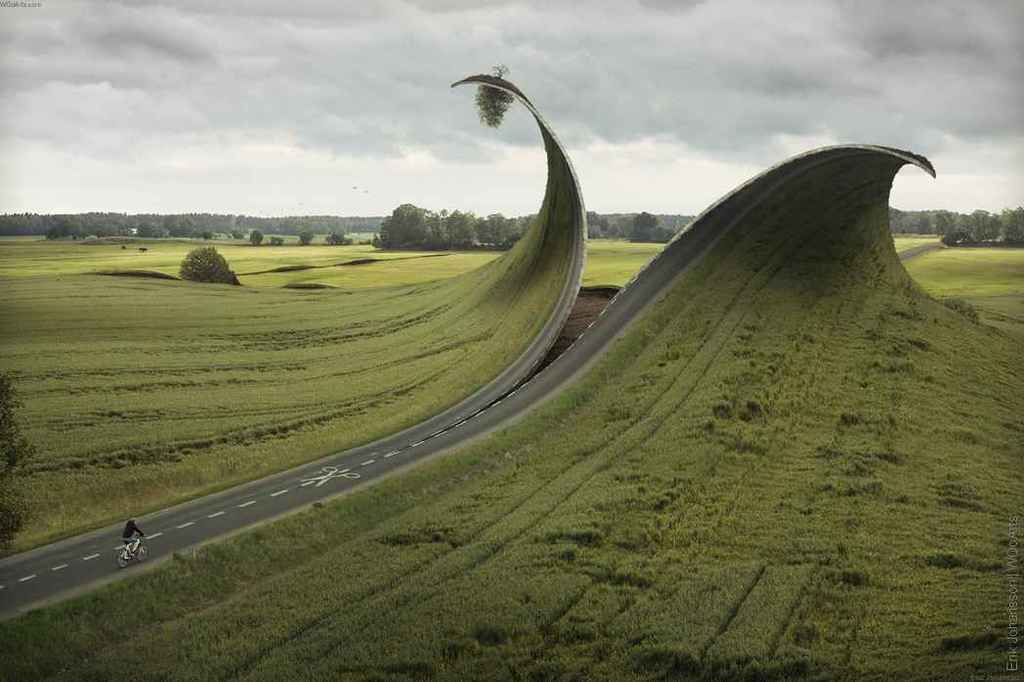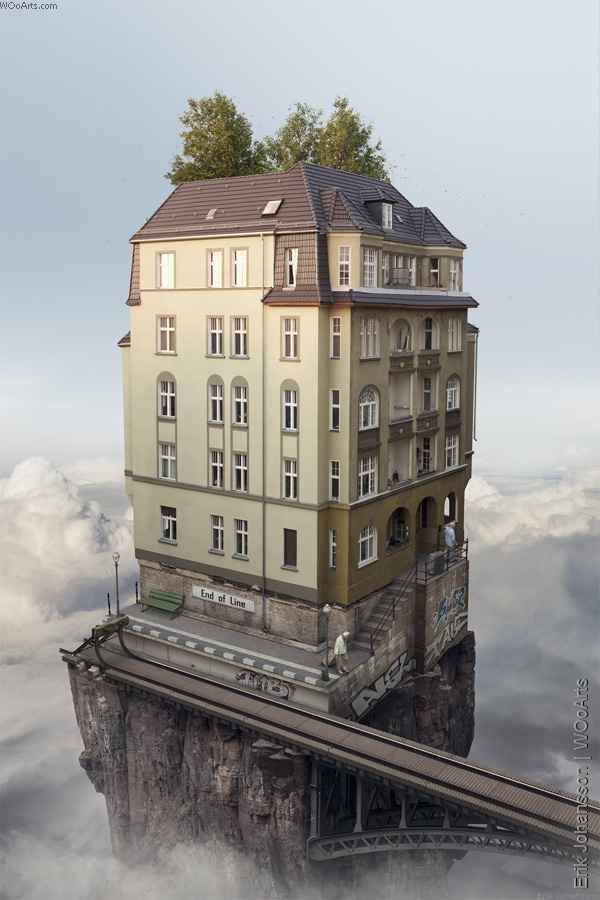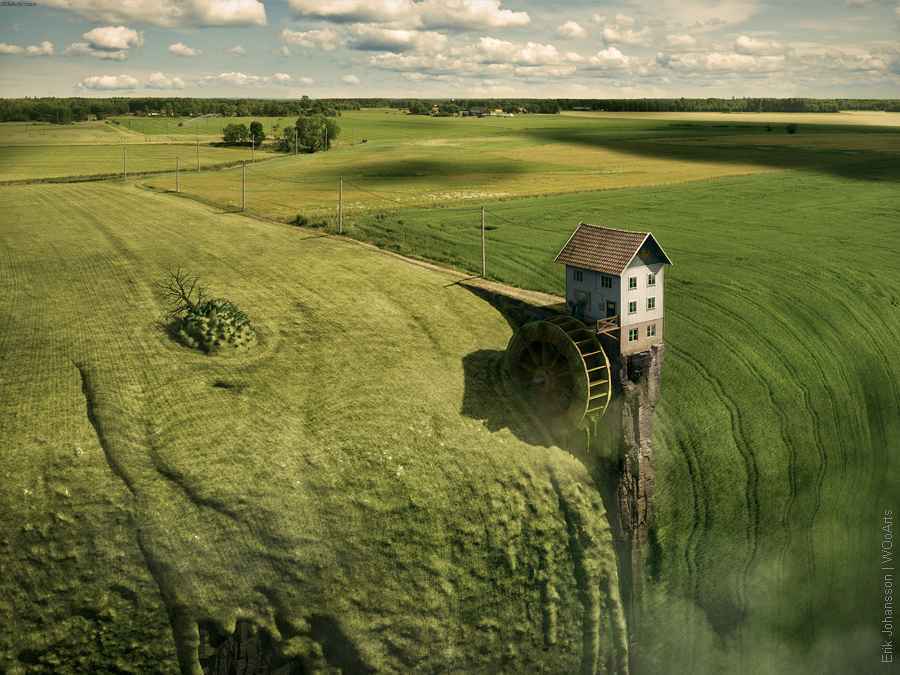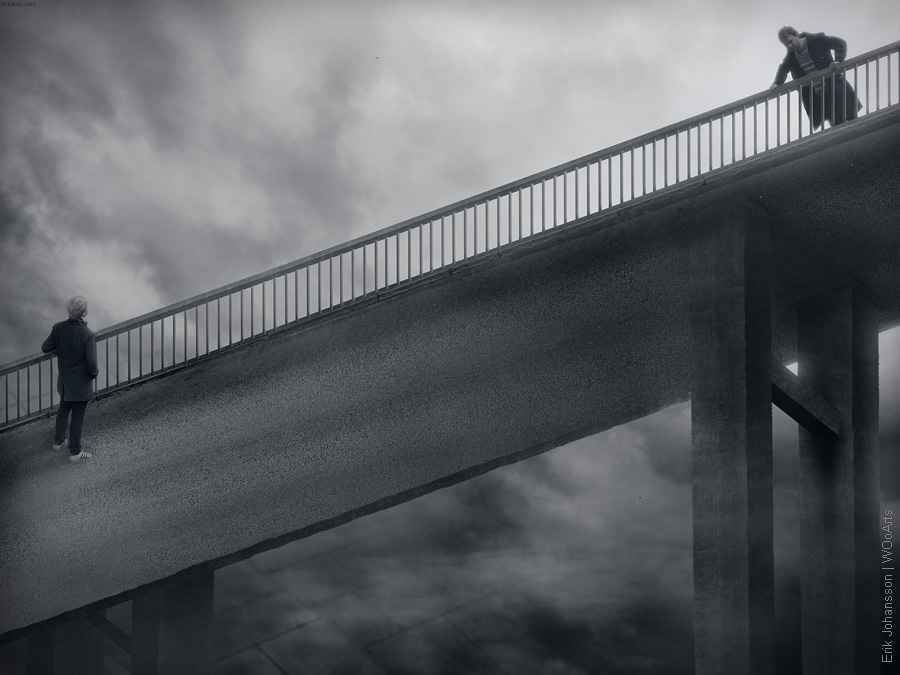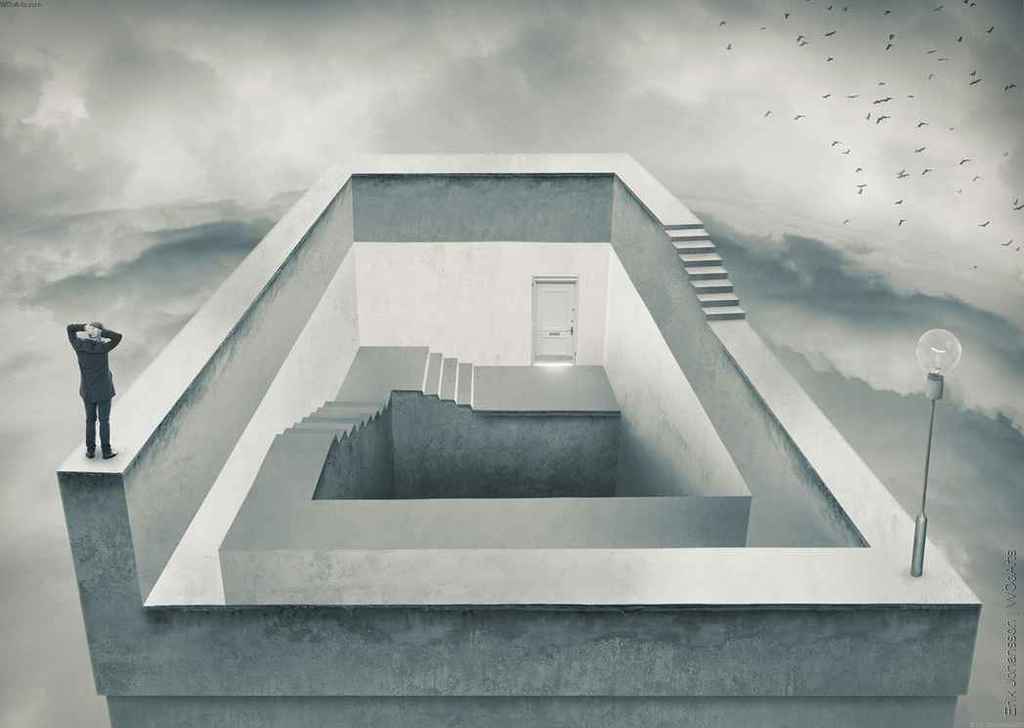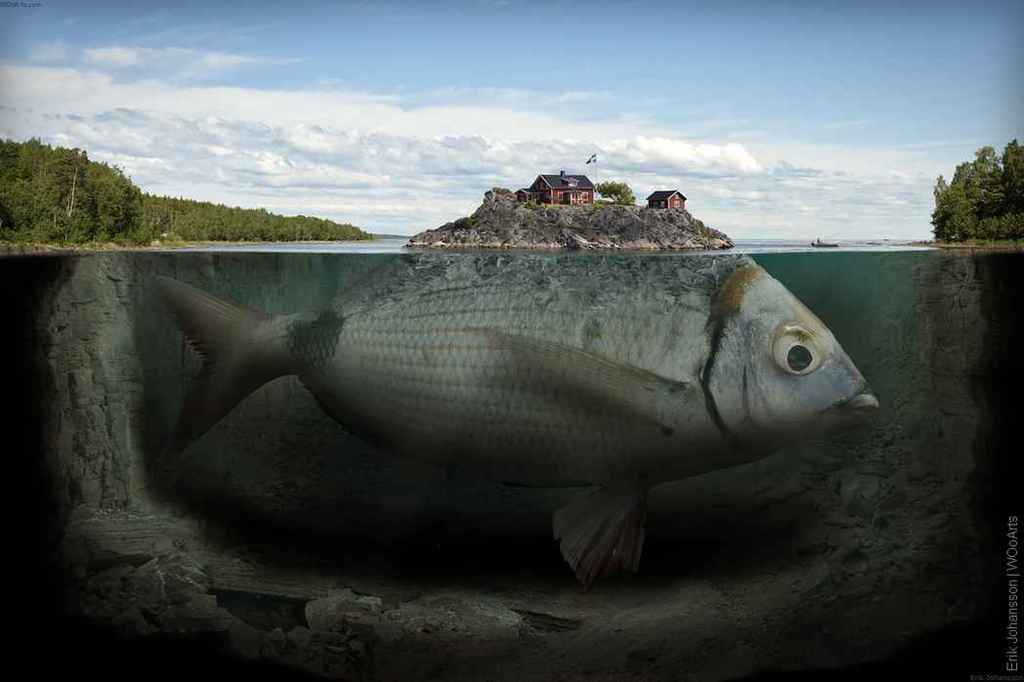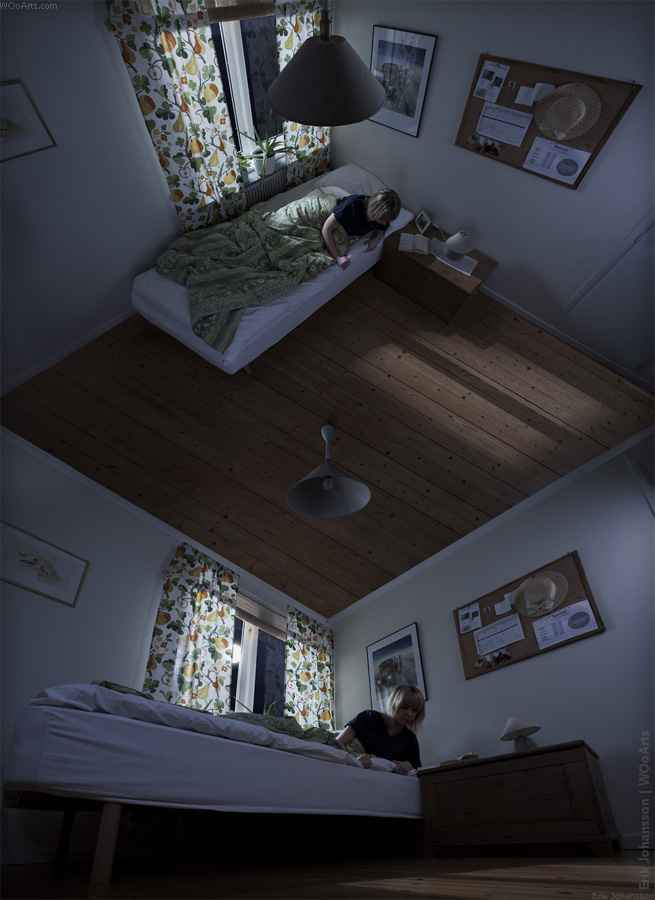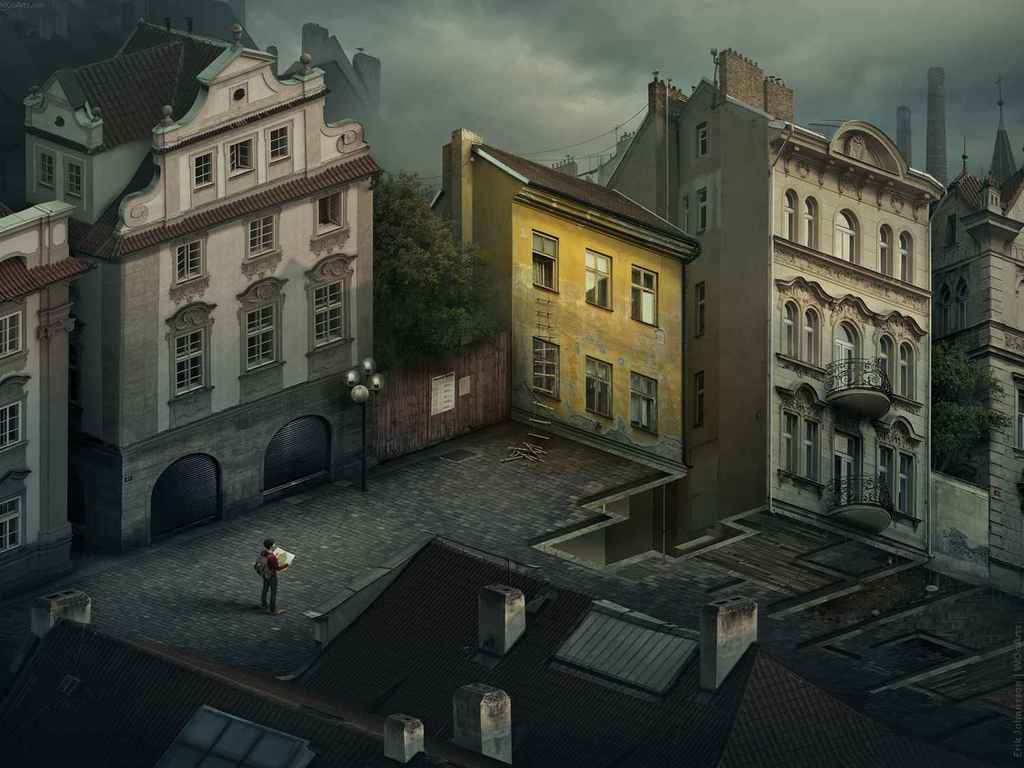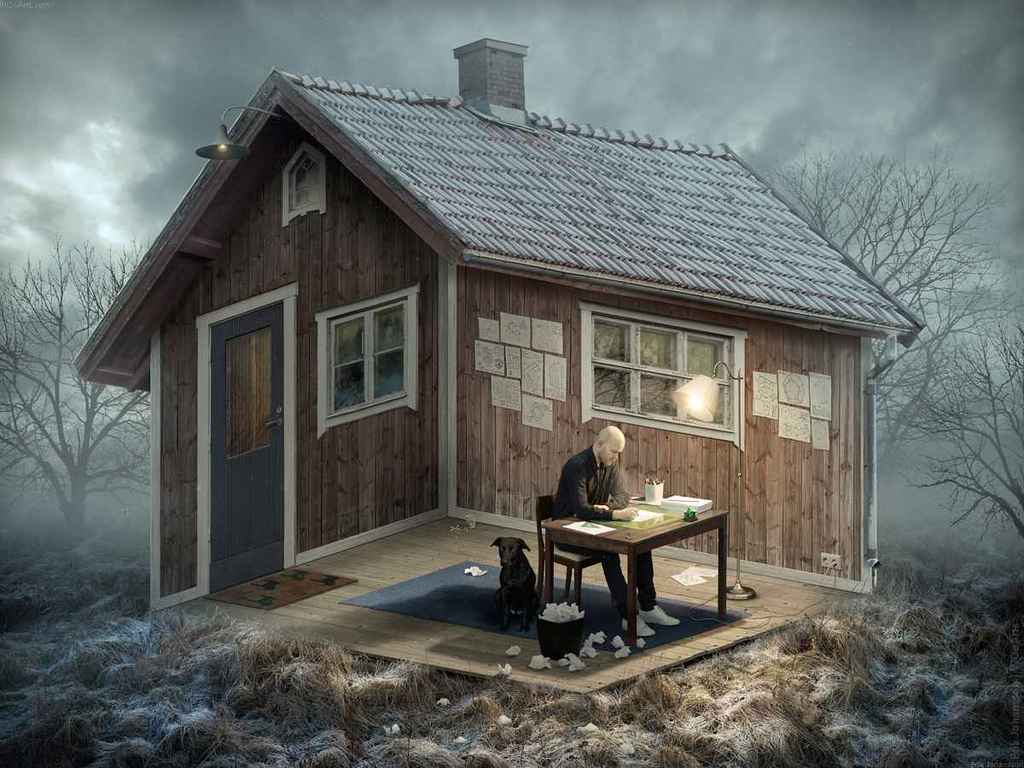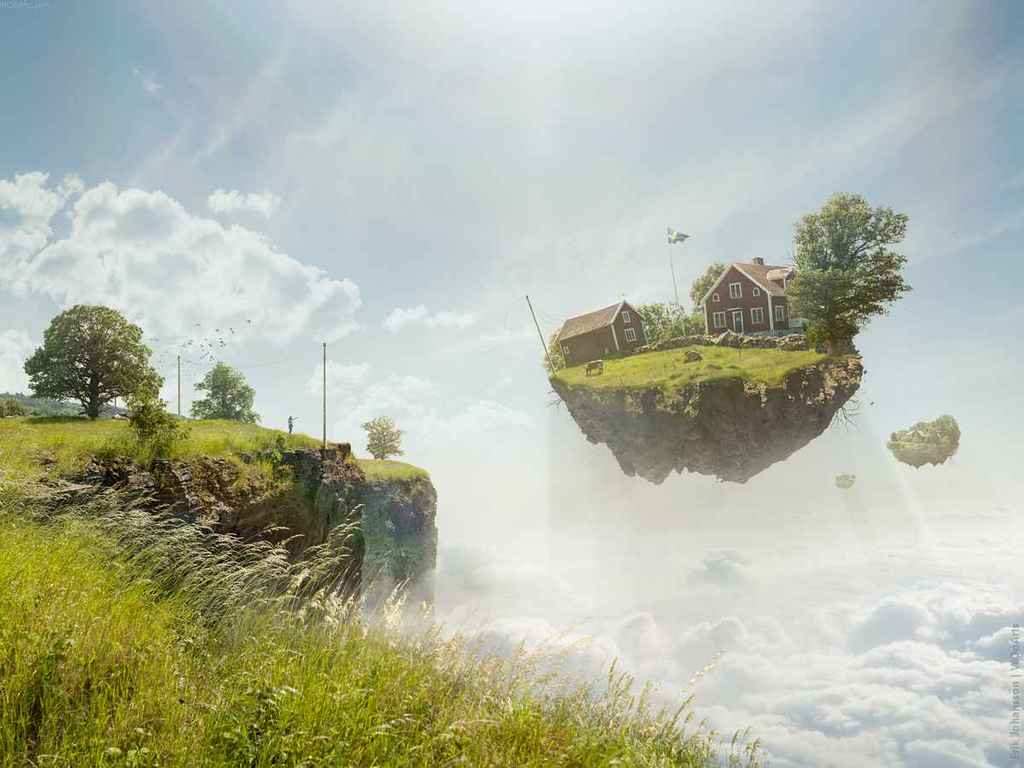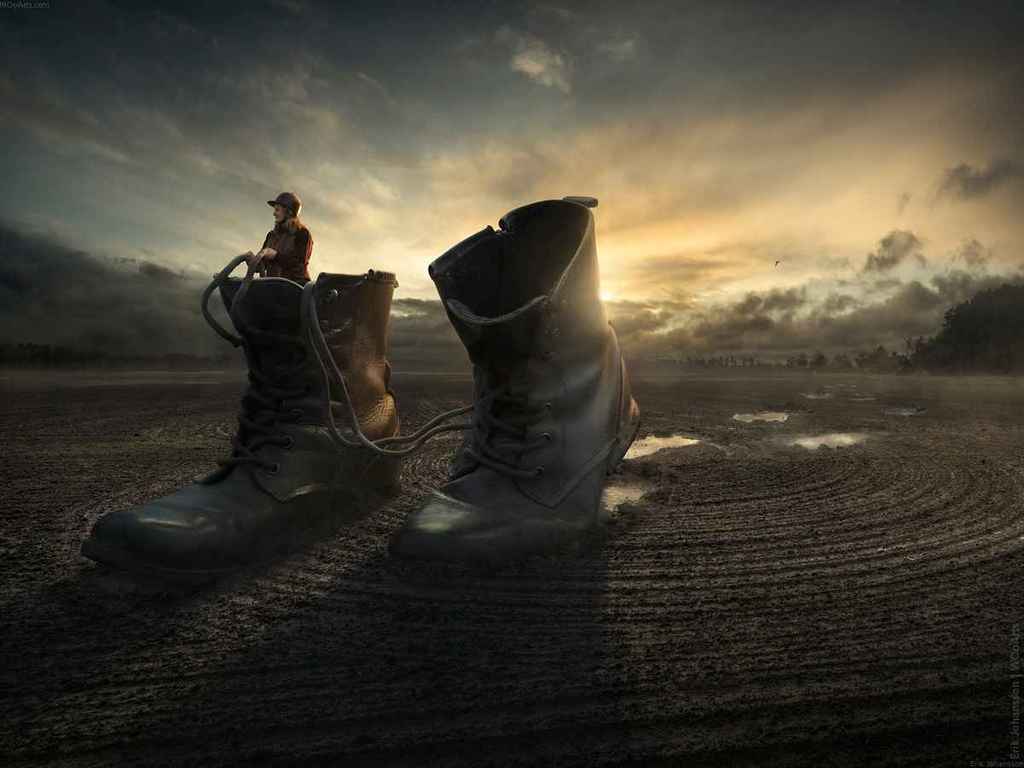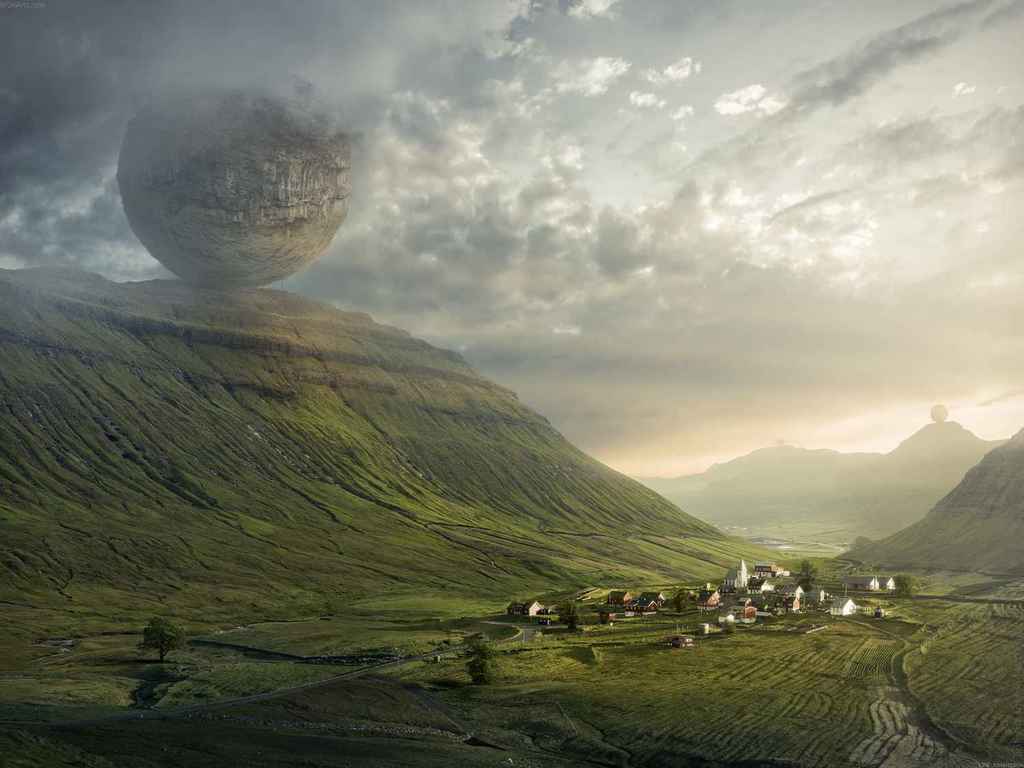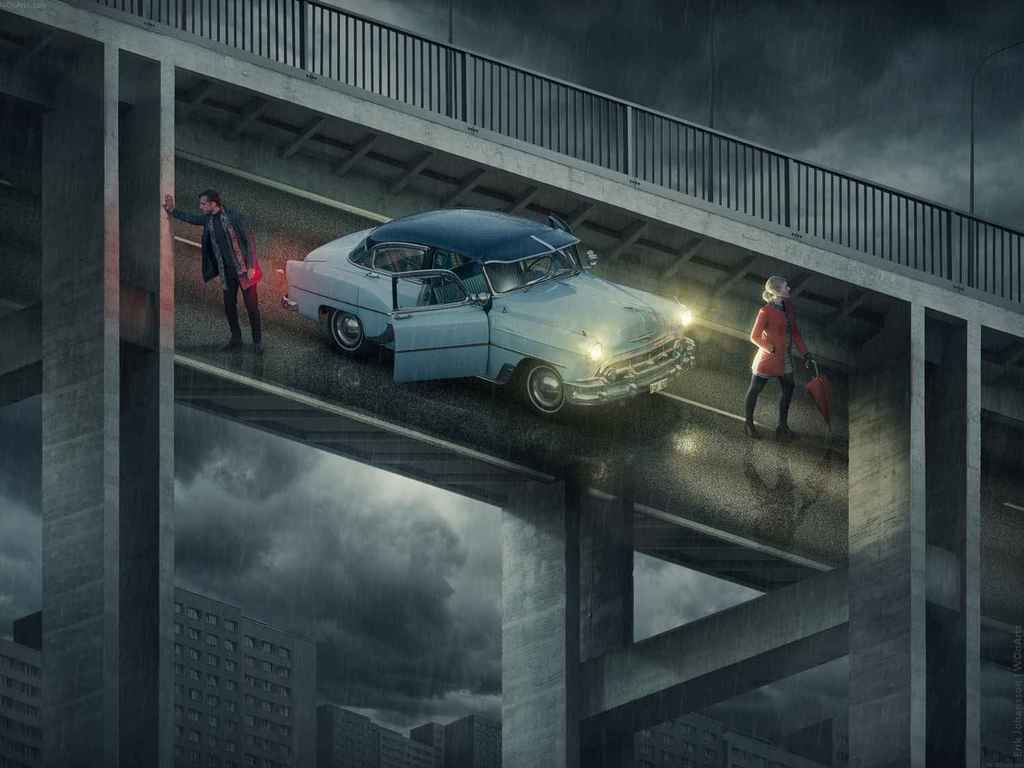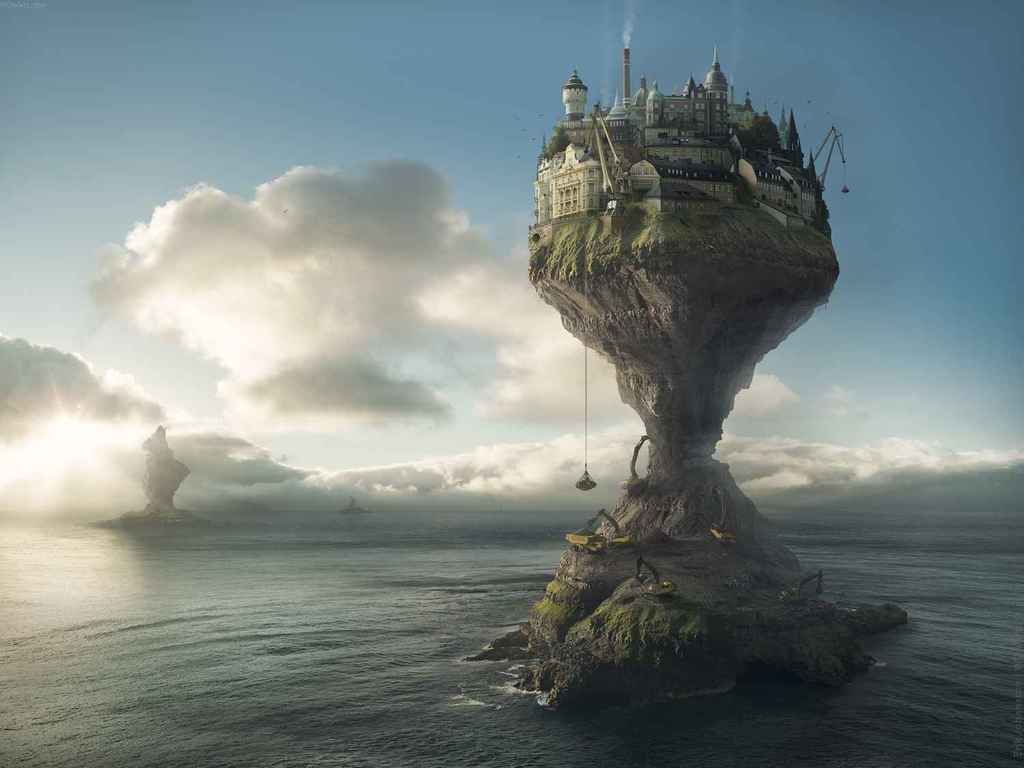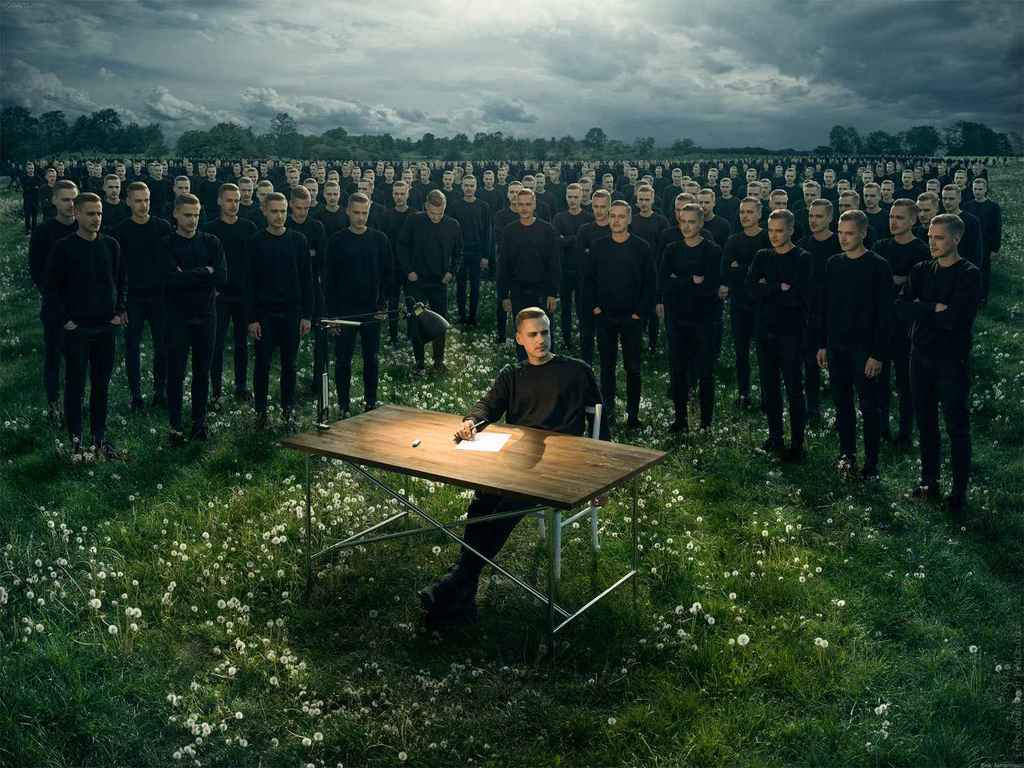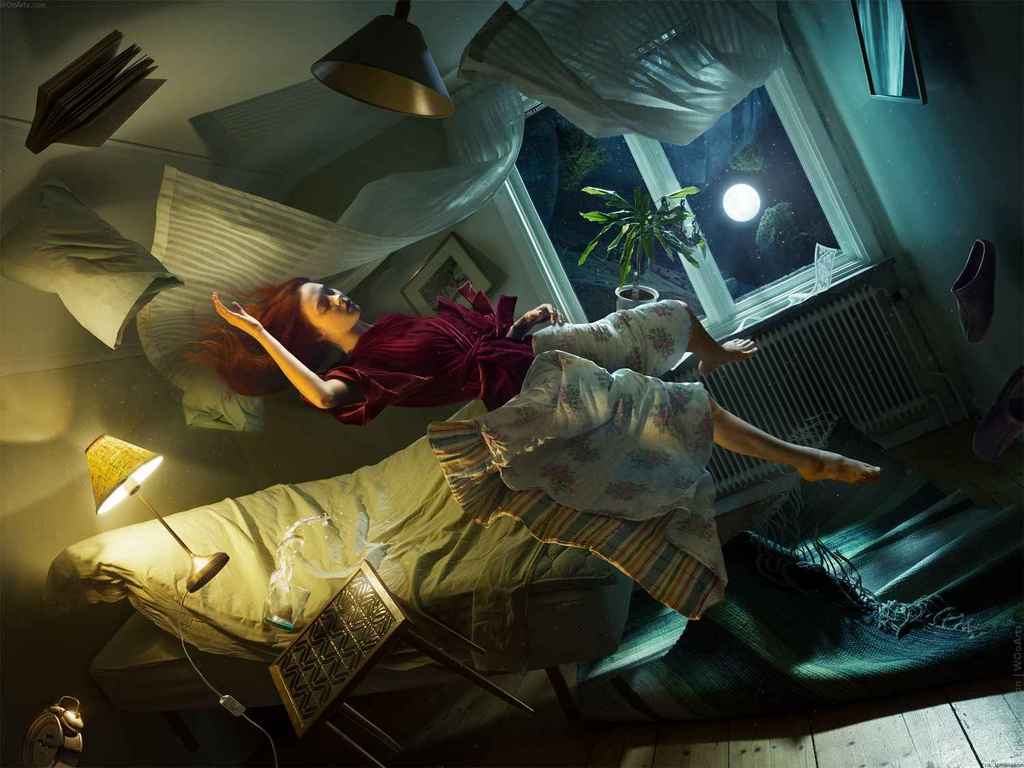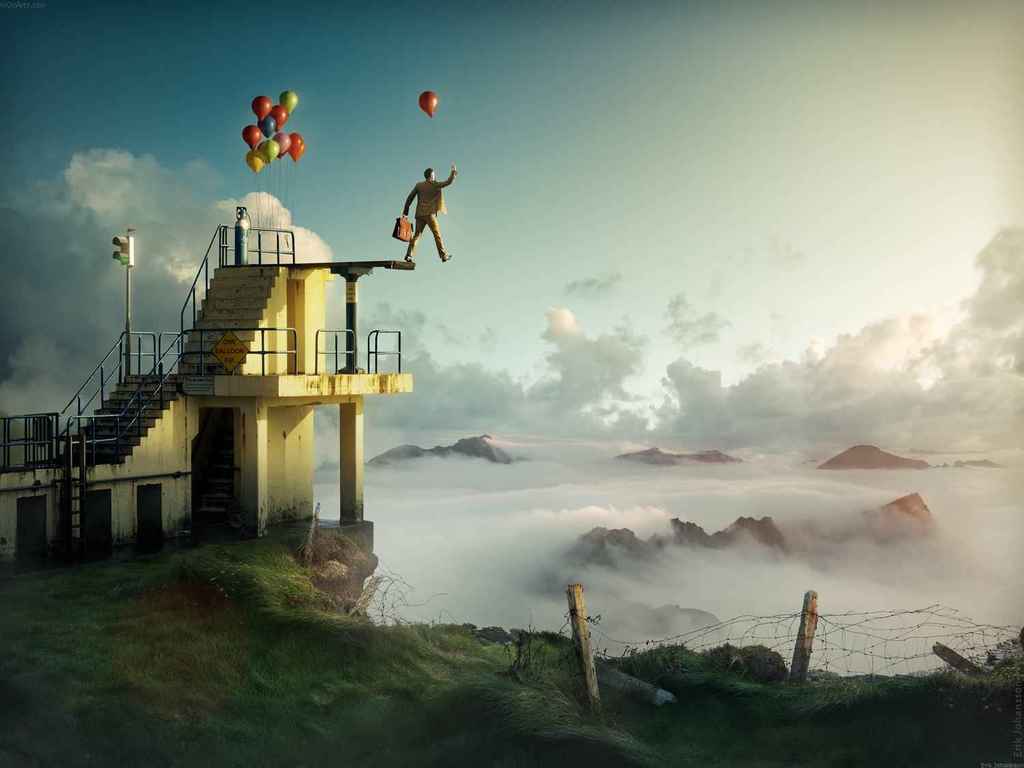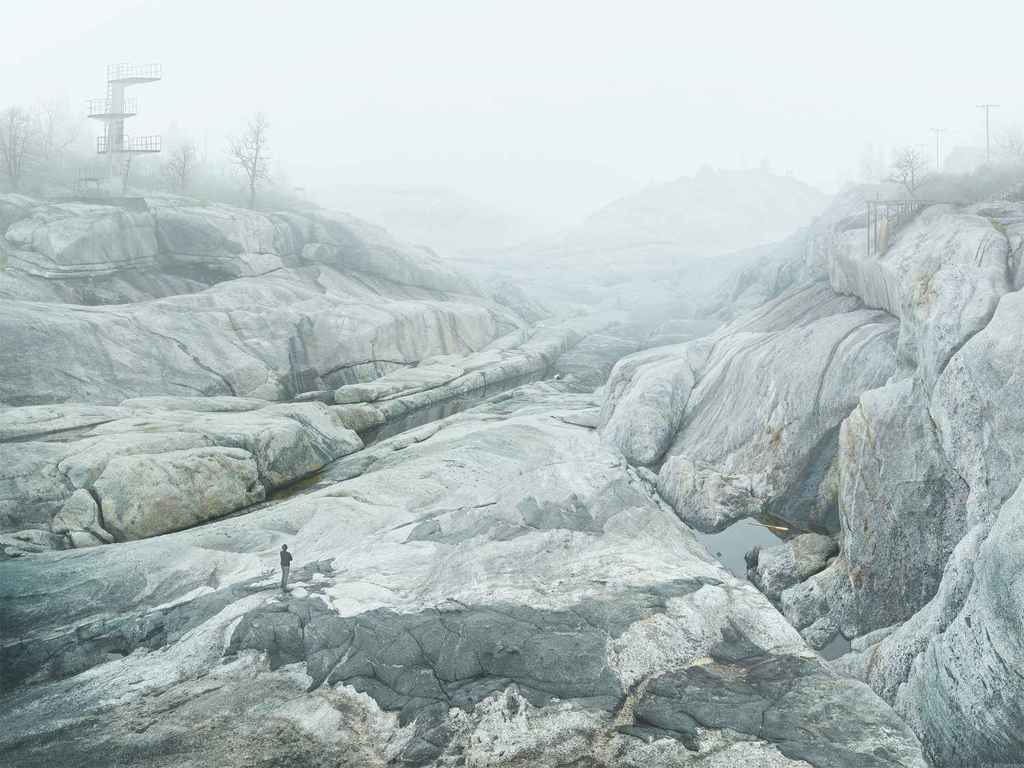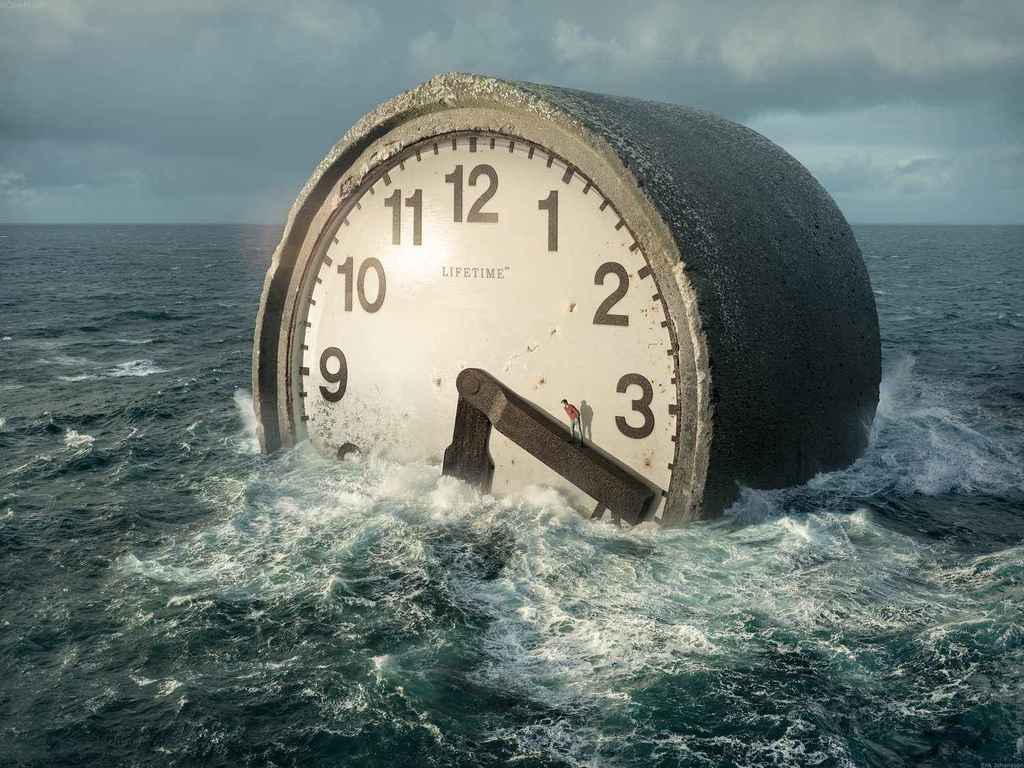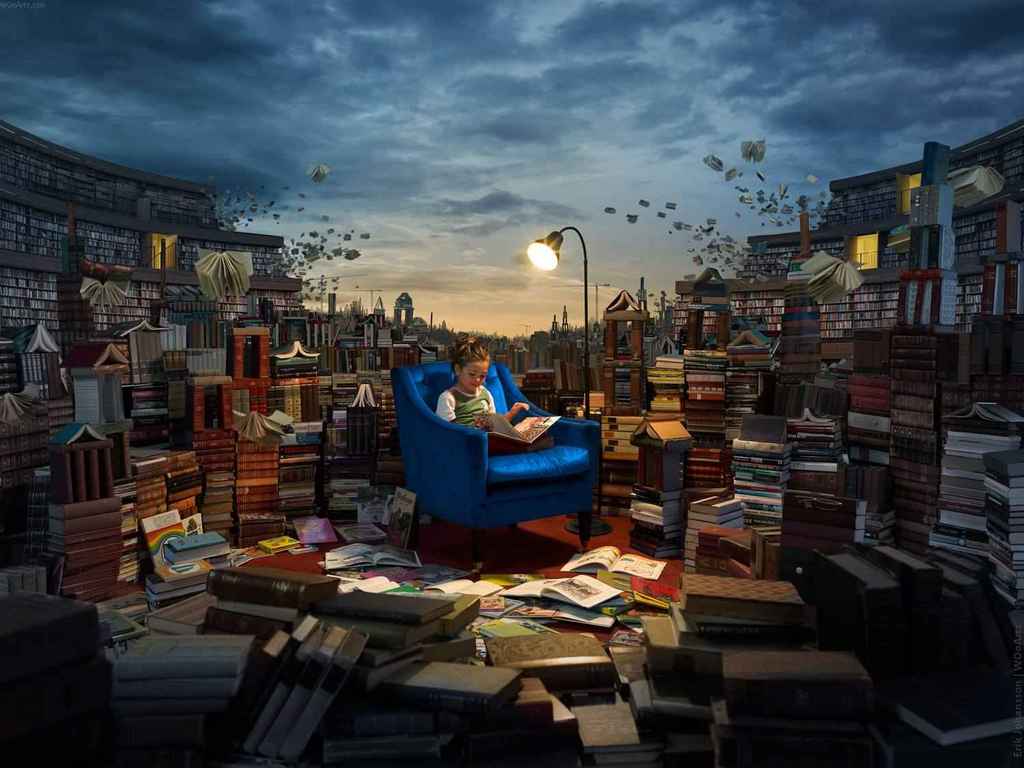Erik Johansson (born 1985) is a photographer and artist from Sweden based in Prague, Czech Republic. His work can be described as surreal scenes created by combining different photographs. Erik works on both personal and commissioned projects with clients all around the world. In contrast to traditional photography he doesn’t capture moments, he captures ideas with the help of his camera and imagination. The goal is to make it look as realistic as possible even if the scene itself contains impossible elements. In the end it all comes down to problem solving, finding a way to capture the impossible.
Surrealism Photography By Swedish Artist Erik Johansson
Erik Johansson Biography
I was born in April 1985 outside a small town called Götene in the middle south of Sweden. I grew up on a farm with my parents and two younger sisters and I spent a lot of time in nature. For as long as I can remember I have liked drawing. Maybe because of my grandmother who was a painter, or maybe because that’s how I always liked to express myself. When my mom asked me how my day in school was I would rather draw a comic showing how it was.The Starting Point To Photography
My dad got a computer for work already in the mid 80’s so I also early developed an interest in computers, mostly by escaping to other worlds through computer games. At the age of 15 I got my first digital camera, a very simple point-and-shoot Fuji camera, but it opened up a new world to me. Being used to the process of drawing it felt quite strange to be done after capturing a photo, it wasn’t the process of creating something in the same way as drawing. You didn’t start with a white empty paper, once you pressed the trigger you were done.
I felt like I wanted to do something more to the photos, where pressing the trigger would only be the start. Having an interest in computers made it quite a natural step to start there. I was playing around with the photos in the computer trying to create something that you couldn’t capture with the camera, mostly very basic modifications like changing color or putting my little sisters on our roof top.
That is how my interest in photo manipulation started, I learned by trying but it wouldn’t become a profession until years later.
I was quite good at mathematics and physics in school and liked the science behind how things work. I went for the natural science program in high school and in 2005 I moved to Gothenburg to study Computer engineering at Chalmers University of Technology.
By that time I didn’t have any plans on doing the photography for a living, I couldn’t imagine it to be a real profession, it was just a fun hobby and didn’t really believe that fun and work could be combined. But during my time studying my friend Eric bought a DSLR (Canon EOS 350d).
This camera was something completely different from the simple point and shoot cameras I had tried up until this point. I was out taking pictures with Eric a few times and it led to me also getting a DSLR (Canon EOS 400d) the year after. I took up my interest for photography and photo manipulation once again but this time having a better camera I felt like I wanted to spend more time manipulating them as well.
The Photography And Photoshop
I had learned the basics by playing around in Photoshop and I started spending more time on each photo. I had a lot of ideas that I wanted to bring to life and it was a lot about problem solving trying to make it look as realistic as possible. After publishing some of my images online I started to get requests helping out with some retouch for a few local advertising agencies.I slowly started freelancing in parallel with my studies while still working on my personal projects. I got more and more work requests and by the time I finished my studies with a master in Interaction Design I felt like I rather wanted to try out the photography path, at least for a while to see how it went.
It was time to change environment after 5 years in Gothenburg so I moved to Norrköping in the eastern part of Sweden to try out the life of a freelance. I made new friends and work slowly stared to take off. At first for some advertisement agencies in the town but by having my work published online I also stared to get international requests.
In early 2012 it was time for something new again and I packed my bags for Berlin, Germany. I’ve always thought that inspiration lies within the contrast between things and I think moving from time to time can be very inspiring. Once again I had to restart, meet new friends and get to know a new city.
I had 4 great years there but in November 2015 I moved once more to Prague, Czech Republic, and that is where I am currently based. I’m still new to the city and I’m excited to see what it can bring.
Although I’m moving around Sweden and the north European landscapes is something that I’m constantly coming back to for taking pictures and finding inspiration. I believe that inspiration lies in the contrast between things.
Becoming Professional Photographer
Today, I work as a full photographer on personal and commissioned projects. But I also do unusual projects like a street retouch pranks or anamorphic illusion installations, I like a challenge and to play with peoples perception of what we think is reality.
I’ve been working with clients such as Volvo, Toyota, Google, Adobe, Microsoft and National Geographic. I love doing my personal projects but it’s also satisfying making someone else’s vision come to life. I think growing up on the Swedish countryside had a big impact on my visual style.
A lot of the environments in my photos are captured near places I know, around my parents’ home with wide open landscapes and small red houses. Inspiration is everywhere and once you learn the tools you’re only limited by your own imagination.
I feel like I’m just getting stared for real, there are so many more projects waiting to be put to life.
I’ve spoken at some conferences including the TED conference in London in 2011. In early 2016 I released my first book “IMAGINE” featuring the first 9 years of my personal projects.
inspire, be inspired
Erik, June 2016
Questions & Answers
This is a selection of the most frequently asked questions.
Q: Where did you learn how to create these images?
I am self-taught in both photography and retouch. I discovered that it was fun to change and modify photos for fun in the year 2000 when I got my first digital camera. I’ve always been drawing for as long as I can remember and when I got the camera I felt like I wanted to do something more with the photos. I started playing around with the photos in the computer and discovered photo manipulations. For me the realism has always been very important and it’s a challenge to make a sketch come to life in a photo. I learned by trying, it took some time and I’m still learning but when you learn the basics of the tools it’s just the imagination that sets the limits.
Q: Where do you find inspiration?
I get inspiration from all things around me. Anything from things I see in my daily life to other artist’s work and music. I think it’s a lot about looking at the world from a different perspective. I get more inspiration from painters rather than photographers . Here are some websites and blogs I visit regularly for inspiration:
http://twistedsifter.com/ , http://thisiscolossal.com , http://inspire.2ia.pl , http://patch-22.tumblr.com , http://www.yerkaland.com , http://www.deviantart.com
Q: What people inspires you?
Here are some artists that inspires me:
- Salvador Dali – Spanish surrealist painter
- M.C. Escher – Dutch graphic artist
- René Magritte – Belgian surrealist artist
- Rob Gonsalves – Canadian painter
- Jacek Yerka – Polish painter
- Shaun Tan – Australian illustrator
- Mattias Adolfsson – Swedish illustrator
- Sven Nordqvist – Swedish illustrator/author
- Thomas Öberg – Singer in bob hund
Q: What are the different stages to create a photo?
Simplified the process is divided into three different parts. It always starts with a sketch, a simple idea. Not many ideas get realized, but if I think it’s good enough I decide try to make it happen.
The first part is planning. Once I’ve come up with an idea that I think is good enough to realize I need to find the places I need to shoot to put the photo together. This can take anywhere between a few days to several months, sometimes years.
This is the most important step as it defines the look and feel of the photo, it’s my raw material. This step also includes problem solving, how to make the perspective, reflections, materials and light etc. realistic.
The second part is shooting/collecting the material. I never use stock photography in my personal projects, I always want to be in complete control of my photos and feel like I’ve done everything myself.
It limits me in a way that I can’t realize all ideas I have, but limitations are good sometimes to define the work. The same light and perspective is extremely important to create a realistic result when combining the photos.
The final part is putting the photos together. This takes anything from a few days to several weeks. This is actually the easiest step, if I did a good job in the first and second step. This part is like a puzzle, I have all the pieces, I just need to put them together.
Q: What is your background? Have your studied photography/retouch?
I studied computer engineer at Chalmers University of Technology in Gothenburg, Sweden 2005-2010. I graduated in 2010 with a master in Interaction Design.
I’ve always had a big interest for both drawing and computers. I think that is one if the reasons why it was a natural step for me to modify the photos in the computer. Photography and retouch always felt more like a hobby so I choose the engineering path instead.
As I finished my studies in 2010 I already worked part time as a freelance doing work for some smaller jobs for advertisement agencies in Sweden. Although I still find interaction design and UX a very interesting subject, photography and retouch is my passion and what I love.
That made me become photographer/retoucher on fulltime when I graduated.
Q: I want to learn to combine photos and photoshop like you do, what advice do you have?
I believe that the best way of learning is by trying, maybe you don’t learn the fastest or correct way, but at least you learn what the different tools do and what YOU can do with them. To become good requires a lot of patience and practice and there are no shortcuts.
Try to find your style and search for tutorials online to get started on specific techniques. Good material is the key to get a good looking result, start shooting all the material yourself, you don’t need a fancy camera to get started!
Most importantly, don’t create what you THINK people want, create what YOU want. Good luck, have fun!
Q: Do make any tutorials?
No, just google Photoshop tutorials. If you understand Swedish I would strongly recommend the Swedish website Moderskeppet. They have tons of resources and explain in a very simple understandable way.
Their gold membership gives you access to tons of video tutorials in other Adobe software as well.
Q: Can I use or licence your photos for my album cover / book / presentation / product etc?
No, I don’t licence my personal work. All my personal projects are not to be commercialized or connected to any product or brand in any way. It’s important to me that they are stand alone projects without a connection to anything. If you like my style I do accept commissioned projects. Just get in touch with my Agent if you have a project in mind, contact info on the contact page.
Q: Do you accepts commissioned projects?
Yes, just contact my Agent if you have a project in mind, contact info on the contact page.
Q: Can I buy signed prints or posters of your personal work?
Yes! I have three different prints. A small open edition print, not signed or numbered. I also have limited edition prints available in two sizes and editions. All prints look great regardless the size. To find out more about the prints just have a look at the shop.
Q: Do you have a book about your work?
Yes! It’s a beautiful book containing my best works so far. It’s called “IMAGINE” and is available in many book stores and on amazon.com. You can find out a bit more about the book here.
Q: Do you work full time with photography and retouch?
Yes, I try to find time to work with personal projects as well but the commissioned projects are what I do for a living. Although my personal projects are what I love it’s fun and challenging to realize other peoples ideas as well. Sadly, I don’t spend as much time on my personal work as I would like to.
Q: How long does it usually take to realize one photo from idea to final piece?
It can take anything from a few weeks to several months. Some ideas requires even longer time as it’s hard to find the perfect spot to shoot or maybe it’s the wrong season. For commissioned projects with a hard deadline it’s of course usually faster, normally a few weeks from “go” to final image.
Q: How would you describe your style?
Photo realistic surrealism. Surreal ideas realized in a realistic way with a touch of humor. I can’t really say that I’ve decided what I want my style to look like. It becomes what it becomes, I just realize the ideas that come to my mind and I didn’t chose develop a specific style to make that happen.
Q: Does music play a role in your work?
Music is a very important part of my work. I always listen to music when I do the post production, mostly electronic music as it gets me into a good flow but it can be pretty mixed. Would you like to listen to what I listen to? Here are some playlists I created:
Q: What do you do when you’re not working? Do you have any hobbies?
I go bouldering sometimes, running when I can and sometimes swimming in the morning. I used to practice Brazilian Jiu-Jitsu for three years and I would love to take that up again. I enjoy good restaurants, playing guitar and seeing new places. I also like cat videos.
Q: What equipment do you use to create your images?
A short summary of the tools I use the most to create my photos:
- Camera: Hasselblad H6D-50c
- Lenses: Hasselblad 24mm, 35-90mm, 50mm, 120mm
- Light: Elinchrom RX, Canon Speedlites, “the sun”
- Monitor: Eizo Coloredge CG318-4k
- Computer: Home-built PC, Windows 10
- Softwares: Adobe Photoshop CC & Adobe Lightroom
Interviews:
IMPOSSIBLE PHOTOS OF ERIK JOHANSSON
By Stefan Gruenwedel
via Adobe Create Magazine
Despite a lack of formal training in photography or studio art—or even classroom instruction in Adobe Photoshop—Erik Johansson has become a master at the art of photo retouching in only a few years.
His impossible landscapes seem alternately humorous and menacing, trapping their inhabitants in vexing circumstances beyond their control as if they’re witnessing a break in the space-time continuum.Echoing the mathematical preciseness of M.C. Escher and the jocularity of Salvador Dalí, among others, Erik’s photographs depict attractive, compelling landscapes where up is often down and perspectives are always misleading.
His artistry is evident in the sheer realism that he manages to embed in his scenes, no matter how absurd.
Originally from Götene, Sweden, Erik spoke with us from his new home in Berlin, Germany.
REALISIC IMPOSSIBILITIES
Stefan Gruenwedel: Your image Cut & Fold is a stunning piece of work. It shows a lush countryside that threatens a bicyclist in an oddly humorous way. Where did the idea come from?
Erik Johansson: I thought about landscapes being like paper, and I thought about the dotted line in the road. I made the connection between that and how when you’re supposed to cut something out of a magazine, you cut along the dotted line with scissors. I mixed those two together; I looked at that and thought maybe a landscape could be like paper.
Gruenwedel: Once you have an idea, it must become quite a challenge to make it happen.
Johansson: Yes, it always starts with something simple like an idea. And I have to figure out how to execute that idea in the most visually pleasing way. There’s a lot of planning involved.
Gruenwedel: Your behind-the-scenes video for Cut & Fold makes that planning clear. We see you assemble a huge number of grass, sky, and tree images to make your photo look real. It’s not just about using Photoshop; there’s a lot of craft involved, even using paper and scissors, appropriately enough.
Johansson: I wanted to do something with paper—something more physical, not just a retouch project. Although I obviously use Photoshop quite a bit, I try to do as much as possible in-camera, which makes the illusion look more realistic and makes things easier during post-production.
INSPIRING LANDSCAPES
Gruenwedel: How has growing up in the Swedish countryside shaped your art?
Johansson: I think it plays a really big role, especially with my personal work. I have to know where to find the environments that I have in mind. A lot of scenes in my pictures are actually captured around where my parents live because I know those areas quite well. My ideas are often connected to the Swedish countryside. It’s very flat where I come from, and that’s why my scenes are quite wide and big.
Gruenwedel: Are lush landscapes, no matter how weird, becoming your signature look?
Johansson: Now that I’ve moved to Berlin, I will probably shoot more urban scenes.
Gruenwedel: Why Berlin?
Johansson: I wanted to move to a bigger place. In Sweden, only Stockholm or Gothenburg is big enough for the kind of work I do. I’ve always liked Berlin, and I think it’s a very interesting place for art and photography. It’s great for inspiration. Because of the former Berlin Wall, you have a contrast between the different parts [former West and East sectors]. You can find really big, abandoned buildings in the middle of the city, and just a couple of hundred meters away, you can see really nice, modern houses. I am sure I will draw on that contrast in my future work.
KEEPING IT REAL
Gruenwedel: Your pictures make Sweden look beautiful and real.
Johansson: Well, I usually change everything in them. The foreground is one picture, and the background is another. It’s pretty hard to find one location that has it all. I just compose it to make it look real. It’s usually easier to have everything in a separate layer in Photoshop because then you can change it exactly the way you want.
Gruenwedel: Such as the background trees and sky.
Johansson: Yes, every tree and sky. I always cut out the sky [in my shots] so I can pick one that suits my idea best. They’re all in layers.
Gruenwedel: How many photos did you take for Cut & Fold before you were satisfied that you had enough coverage?
Johansson: I don’t know, maybe 10 to 20 pictures. That one has about 130 layers. I try to work as nondestructively as possible so I can go back and change different parts even when I’m doing the final touches.
Gruenwedel: Even though your scenes are fantastic, they maintain a sense of reality. Why is realism important to you?
Johansson: I see myself as a photographer who can’t quite capture my ideas solely with a camera. Photoshop is just a way for me to realize the idea I have in my head. Since the camera captures something real, I want to make my pictures look realistic, as if they could have been captured somehow.
Gruenwedel: You seem to like how the brain can be tricked into seeing something, even briefly, that’s not really there.
Johansson: I like illusions—when something looks like something else. That’s why I like the perspective illusions and double-perspectives of M.C. Escher. I also like the feeling and colors of Salvador Dalí and the playfulness from some other artists. I try to pick the best from all of them and imagine how I can do something in a similar fashion but with photography.
Gruenwedel: Do you have a favorite image that inspired you?
Johansson: Escher’s picture with the staircases going through the wall and floor and ceilings—I think that picture [Relativity] is just amazing and really simple in a way, but at the same time extremely advanced. The way he connects mathematics to art is really fascinating.
Gruenwedel: What do you mean?
Johansson: The way Escher creates his work—how something would look—has a lot to do with calculations. Since you can’t see something like that in the real world, you have to imagine how you can create it. And then you have to understand nature, and nature is mathematics in a way. That’s the model to interpret the world.
PROCESS
Gruenwedel: Step us through your process from idea to completion.
Johansson: I divide the process into three different steps.First you have the planning or problem-solving phase when you come up with an idea. It’s the most important step. You find locations and figure out what you need to shoot to be able to create this idea. For example, if you want to make a road look like fabric, you have to shoot a road and then you obviously have to shoot some fabric.
After you find all the locations, you then move on to the second step, which is the photographing phase where you collect all the different materials you need. To me, photography is just a way to collect the material I need to create my picture.
The third step is post-production, which is basically like putting a puzzle together. I have all the pieces I need; I just have to create the final composition.
Gruenwedel: Do you do all the work in each step yourself?
Johansson: Yes. I think that’s really important because if I both shoot and put it together, it makes it easier to know what exactly I need to do in each phase of the process. That’s one of the reasons why my work looks the way it does.
Gruenwedel: How do you alter your involvement in the process for your commissioned work?
Johansson: It depends. Sometimes a company contacts me directly, and then I am involved in the whole idea process. Other times I work with advertising agencies, and usually they have an idea, and they need me to realize it. And sometimes I work with other photographers, and I just do the post-production.
WORKFLOW
Gruenwedel: Describe your post-production workflow.
Johansson: I do everything on a PC running [Microsoft] Windows 7. Besides Photoshop CS6, I use [Adobe] Lightroom 4 for selecting the different photos.
Whether it’s for personal work or commissioned work, I select and rate the different photos that I think are the best fit in Lightroom, and then I open them in Photoshop and start to put it together to see roughly what it looks like. I build the piece up from the back. If I have a really complex background layer, I usually put everything together as two smart objects to make it easier to work with big files like this.
Gruenwedel: What about your hardware configuration?
Johansson: I have one 24-inch screen for the Photoshop canvas, and I have a 22-inch screen tilted at 90 degrees for all the Photoshop panels. I have a Wacom Intuos5 touch Medium board, too. I use the mouse as much as I use the Wacom board. I don’t know why but, for precision, I think it’s sometimes easier to use the mouse. But the tablet is great for shading.
Gruenwedel: What about in the field?
Johansson: I have a computer with me, so I can review the pictures I shoot in Lightroom [tethered shooting]. When I come up with ideas, I just make a note in my phone or do a quick sketch or something so that I can keep my ideas fresh.
I don’t have a tablet. If you could shoot and make it appear on the tablet that would be great. For portfolio work, I have a print portfolio that I bring to agencies. I’m a big fan of prints, actually. I really like the way you see the detail in the print compared to on the screen. I always prefer that.
FEEDBACK
Gruenwedel: You’ve mentioned that you pretty much work alone but I’m wondering whether you ever bounce your ideas off others.
Johansson: Feedback is really important to me. When you work on a picture for such a long time—sitting 10–20 hours throughout the week with a photo—it’s really hard to see it the way someone else would see it the first time. So before I publish the work on my website, I usually put it up on different photo community websites to find out what people feel when they see it. I get more technical feedback from my photography friends—like if a shadow doesn’t look right or if something looks weird. It’s good to get all kinds of feedback.
FOOLING THE PUBLIC
Inspire: You’ve done some interesting public art. How did that happen?
Johansson: Last year Microsoft asked me if I wanted to be in a project called Generation 7 where seven selected talents in different areas were offered resources to realize their dream project. I thought it would be interesting to do something like an installation. I like how those street artists do 3D illusions with chalk and paint, and I thought it would be interesting to see if I could do that with photography—maybe make it look even more realistic.
Inspire: It’s fun to watch people interacting with them.
Johansson: Yes, Mind Your Step is the biggest one I’ve done. I wanted to involve a lot of people, so I picked a big open space in Stockholm. And I thought it would be more interesting to do it on the ground instead of a wall so that people would be able to interact with it.
Inspire: Your video of the fake doorway leading into a shop is really funny. Someone tries to walk into it.
Johansson: It’s actually a friend. I asked him just to walk by and look at the door, but he suggested trying to walk into the door. It’s a nice way to get some views on YouTube.
INSPIRING OTHERS
Gruenwedel: You like to show how your fakery works. You have a video of an illusion demonstration, for example.
Johansson: The reason why I do the behind-the-scenes stuff is to inspire people and show them my works in progress—the same way I get inspired by others. My advice to other people is that trying is the best way of learning. It’s nice to look at a certain technique that’s explained in a tutorial, but you have to get to know the tools yourself by trying them.
It requires a lot of patience and imagination. I mean, everyone can learn Photoshop—and that’s the best thing: everyone is using it, from professionals to beginners. I think it’s an amazing piece of software where only your imagination is the limit.
(Ready to learn more? Check out Photoshop tutorials for all levels—from novice to expert.)
February 13, 2013
Author: Stefan Gruenwedel Photos and artwork: Erik Johansson
Layout: Nicolle Rodriguez and Shadi Moussa
Interview with Master Photo Manipulator Erik Johansson
By Mila Pantovich Jul. 20th, 2012
via justluxe.com
Imagination offers us the unique ability to see beyond our material realities into another world that may not make logical sense, but always resonates with us emotionally. Certain forms of technology have allowed us to present these emotional landscapes in incredibly realistic ways, forcing us to possibly even question what reality means to begin with.
Many artists have taken to playing with these ideas while using photography as their tool, but very few of them are able to present an image so real, it forces the viewer to accept it, not as a material possibility, but as something larger than that.
Born in the small town of Götene, Sweden in 1985, Erik Johansson seemed to have been born with the love of drawing installed within him, which was perhaps inherited from his grandmother, who was a painter.
By the time he got his first digital camera at 15, he already had firmly established his sketching talents, which helped propel him forward into the world of photography. Because of his history with drawing and the finite nature of photography, he began to feel strange to essentially be finished with the work once the shutter snapped shut.
This dissatisfaction led him to photo manipulation, where he began altering his photos using programs like Photoshop, twisting and turning them in whatever ways he could imagine to create something unseen.
However, it wasn’t until after he began studying in Gothenburg in 2005 that he began to post his images online, quickly receiving commission requests by advertisement agencies.
After finishing school with a Master in Interaction Design, Johansson chose to pursue photography full-time, eventually moving to Berlin, Germany and working with various companies like Google, Microsoft, and IKEA. Despite his commercial success, Johansson will always consider his personal projects to be the most important.
With plans to move into motion pictures and books, Johansson’s unending imagination has allowed countless people to explore their own. In 2011 he began doing street illusions, one of which gained national attention. “Mind Your Step” was placed in the famous square Sergels torg in the middle of Stockholm. At 105′ by 59′ feet, the massive image gave the impression of a deep hole in the ground when looked at from just the right angle.
A lot of planning goes into each finished product, always beginning with a simple sketch. After the initial drawing he scouts for locations, always taking his own photographs instead of relying on stock photography (which can sometimes take just one day, several months, or even a year).
Once he finds the right location, Johansson will take the photos needed, having to ensure that similar light and perspective is reflected in each. The last step is piecing everything together on the computer, which he considers to be the easiest part of the entire process.
Inspired by the world around him, especially his place of birth (with the wide open spaces around his parents’ house being the setting for many of his pieces), Johansson subverts aesthetics and expectations, a firm believer that our only limitations in life are those we place on ourselves.
When looking at his photos you can see the impact of Surrealist masters of the past (like MC Escher, Salvador Dali, and René Magritte), and as well as a characteristic wholly unique to Johansson himself.
JustLuxe: Have you ever had such a great idea but found yourself unable to properly execute it (whether because you just hadn’t figured out how yet or because the materials wouldn’t allow it)? Have you ever had to give up on an idea?
Erik Johansson: I get ideas all the time, not every one gets realized, not even one in ten. As I always shoot everything myself I have to chose the ones I’m actually able to find locations for. Every time a new idea pops up I put them in a book and save them for later, maybe I can realize them some day.
JL: You’ve mentioned being incredibly self-critical of your work; if you could (or even wanted to) is there an image that you would alter? Do you have any favorite pieces that you’re especially proud of?
EJ: Sometimes I think of improvements of the finalized images, but I never allow myself to change them. I want to look forward and the flaws are signs of improvements, I hope I never become satisfied, I think that’s very dangerous for an artist. I always want to become better and find new problems to solve.
JL: You’ve said that you don’t use stock photos; does finding the right image in reality to fit with the image in your mind ever pose a problem?
EJ: I don’t use stock photos for two reasons:
1. I think it’s nice to have some restrictions, a way to encage imagination and make the work more consistent, I can only do what I can shoot. That makes the photos reflect the world around me, seasons and locations, and gives it a personal touch.
2. I want to feel like my work is my own, I want to be in charge of every part.
JL: What would you say to someone who thinks that digitally modified images are a lesser form of art?
EJ: If it’s well produced it’s as good as anything else, but I generally don’t like digital manipulation as an art form. It has to be super realistic for me to appreciate it; I don’t say my work always is, but that is what I’m trying to create. Like it could have been captured.
JL: Many of your photos reminded me of the film work done between Salvadore Dali and Luis Buñuel; has their film work ever been a source of inspiration for you?
EJ: I didn’t know about Luis Buñuel until just recently but Dali is a big inspiration. I generally get more inspired by artists than photographers.
JL: I absolutely love “Wet Dreams on Open Waters.” What was your thought process behind it?
EJ: It was a piece I did for a competition on the theme “dreams” at a Swedish photo community, which I won. It was a fun photo to work with, the bed is captured in studio in a similar light and the background was shot at a lake close to my parents home, later summer 2008.
JL: A lot of your pieces depict a sense of isolation, with a lot of lone figures, or doubles separated by a reality divide. Is there a personal symbolic meaning behind this sense of solitude or is it something that’s simply visually striking?
EJ: I have thought about that too but that’s how the ideas pops up, generally I like putting people in my work, someone reacting to what is happening. Also to give it more realism somehow, so it just doesn’t look like a model but a photograph.
JL: Absurdist comedy definitely shines in your work; how does that come about?
EJ: It’s not really something I’m trying to create, it’s just included in the absurdness of my ideas. Some ideas are quite heavy so the comedy creates a nice balance in the work as well.
JL: Many of your photos show humanity as being overwhelmed and dominated by industrialization and urban landscaping; how do you see the growth of industry and what do you think its relationship to human progress is? Are you optimistic about our future?
EJ: I am optimistic. Growing up on the countryside, nature has always been close to me and something positive. But now I live in Berlin and I love it here. It’s not really that I’m trying to create a message, it’s just what comes out of me. People are free to do their own interpretations of my work, I just put a title on it.
JL: You’re an expert at mashing together two halves, that in reality should never work together, but do, allowing the viewer to live vicariously within the created dreamscape; would you say your work is a bridge between the material world and the spiritual unconscious world? Do you feel like you’re carrying on the Surrealist tradition or carving out your own path into new territory?
EJ: In a way I see my work as problem solving, I want to challenge myself to merge two or more worlds and create a realistic transition between them. To make it look realistic, that is the challenge to me. Although I get inspired by surrealist art, I want to go my own way.
I’m not really interested in what has been created in history and how my work looks compared to that. I’d rather look into the future and realize as many ideas as possible during the limited time I’m here.
JL: Do you keep a dream journal of any kind to keep up with your own ideas?
EJ: I’ve tried but I’ve found out that I get most of my good ideas while I’m awake. The ones I get when I sleep are a bit too psychedelic and inconsistent.
JL: Imagination is something people sometimes take for granted and not everyone has it, or some who do begin losing it; do you ever worry that one day your ideas will slow?
EJ: Everyone has their ups and downs, but I’m not really worried; the ideas usually come more often than I have time to realize them. It’s a combination of thinking differently and knowing what could be realized with the tools I have.
JL: How do you feel about the art market today and its role in society?
EJ: I think the Internet has done a lot for art in general. Before, art galleries would decide what’s good and not, today anyone can put their work online and if it’s good, it will spread itself. I think we will see more and more people selling their own work.
To me art is just something I find visually pleasing, I don’t care about the name behind it.
JL: Do you have any more large-scale illusions planned, like “Mind Your Step?”
ER: Right now I’m working on new personal projects, but I would love to do something similar to that again. I have an upcoming smaller illusion in Stockholm, Sweden in September. More information will be available on my website.
JL: Do you have anything coming up that you’re particularly excited for?
EJ: There is a lot happening right now and I might have some very interesting album art to work within the next year. But generally I try to focus on my personal work right now.
JL: I read that you had plans to move into the film industry and start a book project; how’s that going?
EJ: I’ve been busy with commissioned and personal projects this spring/summer but hopefully a film project isn’t that far away. Hopefully later this year.
JL: Is there a question you always wish someone would ask you regarding your work, or one that you wish you’d stop being asked?
EJ: Not that I can think of 🙂
For more information on Erik Johansson, as well as prints for purchase and a comprehensive FAQ page, visit ErikJohanssonPhoto.com.
Check out our favorite photographers for the new year: Visually Stunning Images by Our Favorite Photographers for the New Year

Erik Johansson Photography
www.erikjohanssonphoto.com/music

